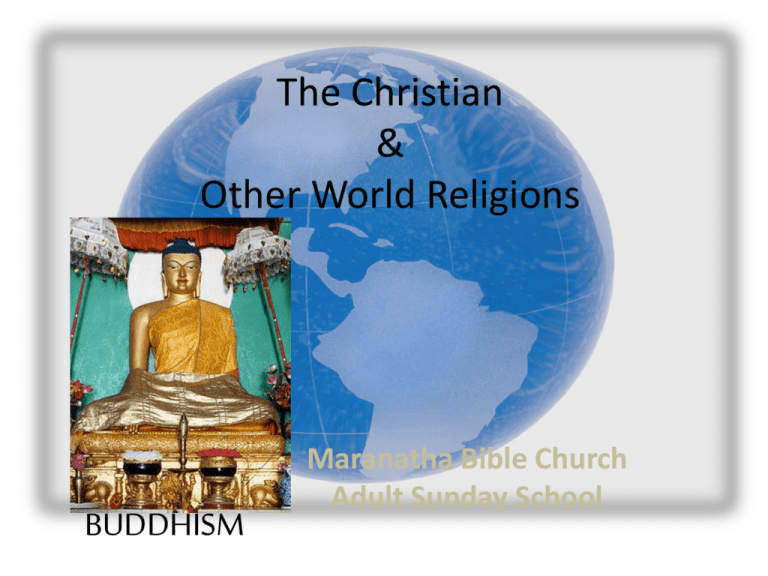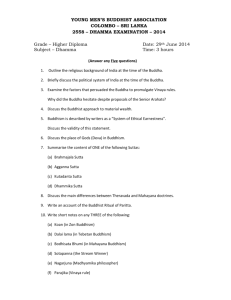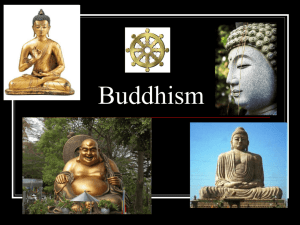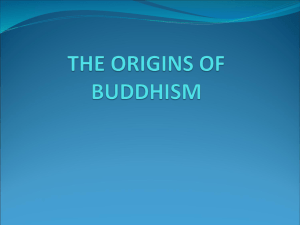
The Christian
&
Other World Religions
BUDDHISM
Maranatha Bible Church
Adult Sunday School
Demographics of Buddhism
~350M to 500M Buddhist
1/8/2010
WRC-MBC-NJB
2
Buddhism - Formation
• Buddhism is a religion and a philosophy
encompassing a variety of traditions,
beliefs, and practices
• Based largely on teachings attributed to
Siddhartha Gautama – commonly
known as the Buddha (Pali/Sanskrit –
“the awakened one”)
– Buddha lived and taught in northeastern
Indian subcontinent sometime between the
6th and 4th Centuries BCE
• Buddha’s purpose in sharing his
teachings was to end suffering, achieve
nirvana, and escape what is seen as a
cycle of suffering and rebirth
1/8/2010
WRC-MBC-NJB
Footprint of the Buddha with
harmachakra and triratna, 1st
century CE, Gandhāra.
3
Background of Buddha (Siddhartha)
• Buddha was born in Lumbini, Nepa (modern day Nepal)
around 563 BCE
• He was raised in Kapilavastu, Nepal (modern day Nepal)
• Shiddhartha was a prince, who’s father was King Suddhodama
• An astrologer visited the young prince’s father and prophesied
that Siddhartah would become a great king or renounce the
material world to become a holy man depending on whether
he saw what life was like outside the palace walls
• His Father was determined he become a King, so he
prevented him from ever going outside the palace walls. But
at age 29, despite his Father’s efforts, Siddhartha ventured
beyond the palace walls several times
– During these visits he had a series of encounters – which became “the four sights”
1/8/2010
WRC-MBC-NJB
4
Background of Buddha (Siddhartha)
• These four sightings were based on his learning of the
sufferings of ordinary people:
–
–
–
–
Encountering an old man
Encountering a sick man
Encountering a corpse
Encountering a holy man who was content and at peace with the
world
• These encounters prompted Siddhartha Gautama to abandon
royal life and take up a spiritual quest
1/8/2010
WRC-MBC-NJB
5
Background of Buddha (Siddhartha)
• Buddha’s first attempted an extreme ascetic life and almost
starved himself to death in the process
– He concluded that extreme ascetic practices such as prolonged fasting,
breath-holding, and exposure to pain brought little spiritual benefit
and viewed them as self-hatred and counterproductive
• He concentrated on anapanasati meditation – now called the
Middle-Way: A path of moderation between the extremes of
self-indulgence and self-mortification
• At age 35, he sat under a sacred fig tree – known as the Bodhi
tree – in the town of Bodh Gaya, India and vowed not to rise
before enlightenment.
– Supposedly after many days, he finally awakened to the ulimate
nature of reality thereby liberating himself from the cycle of suffering
and rebirth
1/8/2010
WRC-MBC-NJB
6
Mahabodhi temple in Bodhgaya, India,
where Gautama Buddha attained Nirvana
under the Bodhi Tree (left)
1/8/2010
WRC-MBC-NJB
7
Background of Buddha (Siddhartha)
• Shortly after this experience, he started a monastic order and
as Buddha, he spent the rest of his life traveling throughout
the northeastern part of Indian subcontinent teaching the
path of awakening
• Buddha died at the age of 80 in 483 BCE in Kushinagar, India
• Not all scholars are in agreement about all of the details of
Buddha’s life but most are in reasonable agreement to these
basic facts
1/8/2010
WRC-MBC-NJB
8
Buddhism – Development
• Developed as a branch from Hinduism
• Two major branches of Buddhism
– Theravada: The school of the elders
– Mahayana: The great vehicle
• Theravada is the oldest surviving branch and has a
widespread following in Sri Lanka and in Southeast Asia
• Mahayana is found throughout East Asia and includes the
traditions of Pure Land, Zen, Nichiren Buddhism, Tibetan
Buddhism, Shingon, Tendai, and Shinnyo-en
• Vajrayana is a recognized 3rd branch but is seen by many as an
offshoot of Mahayana
1/8/2010
WRC-MBC-NJB
9
Expansion of Buddhism
Timeline: Development and propagation of Buddhist traditions (ca. 450 BCE – ca. 1300 CE)
450 BCE
[172]
250 BCE
Sri Lanka &
Southeast Asia
500 CE
700 CE
Mahayana
Early Buddhist schools
Early
Sangha
India
100 CE
800 CE
1200 CE
[173]
Vajrayana
Theravada Buddhism
Greco-Buddhism
Central Asia
Tibetan Buddhism
Silk Road Buddhism
Shingon
Chán, Tendai, Pure Land, Zen, Nichiren
East Asia
450 BCE
Legend:
1/8/2010
250 BCE
= Theravada
tradition
100 CE
500 CE
= Mahayana
traditions
WRC-MBC-NJB
700 CE
800 CE
1200 CE
= Vajrayana
traditions
10
Expansion of Buddhism
Buddhist proselytism at the time of emperor Ashoka (260–218 BCE).
1/8/2010
WRC-MBC-NJB
11
Teachings of Buddhism - Foundations
• The foundations of Buddhist tradition and practice are the Three Jewels:
– The Buddha – Founder / a way or path to enlightenment – bliss (such as it is)
– The Dharma: The Teachings
– The Sangha: The Community
• Taking “refuge in the triple gem” has traditionally been a declaration and
commitment to being on the Buddhist path
– This distinguishes a Buddhist from a non-Buddhist
• Other practices include:
–
–
–
–
–
–
–
–
1/8/2010
Renunciation
Support of the monastic community
Meditation
Cultivation of mindfulness and wisdom
Study of scriptures
Physical exercise
Devotion and ceremony
Invocation of bodhisattvas
WRC-MBC-NJB
12
Teachings of Buddhism - Karma
• Karma – The Law of Cause and Effect
– Comes from the sanskrit word – action, work
– In Buddhism this is the force that drives the cycle of
suffering and rebirth for each being (samsara)
– Good, skillful deeds (Pali) and bad, unskillful deeds
produce “seeds” in the mind which come to fruition either
in this life or in a subsequent rebirth
– The avoidance of unwholesome actions and cultivation of
positive actions is called sila (Sanskrit for ethical conduct)
1/8/2010
WRC-MBC-NJB
13
Teachings of Buddhism - Salvation
In Theravada Buddhism there can be no divine
salvation or forgiveness for one’s karma, since it is a
purely impersonal process that is part of the make up
of the universe
Some Mahayana traditions hold different views
The Lotus Sutra, Angulimaliya Sutra, and Nirvana
Sutra claim that reciting or merely hearing texts can
expunge great swaths of negative karma
Vajrayana traditions hold that recitations of mantras
are a means of cutting off previous negative karma
1/8/2010
WRC-MBC-NJB
14
Teachings of Buddhism - Rebirth
•
•
Rebirth is a process whereby beings go through a succession
of lifetimes as one of many possible forms of sentient life,
each from conception to death
Buddhism rejects the concepts of a permanent self or
unchanging, eternal soul – There is NO GOD!
–
–
•
There is no such thing as a self (the doctrine of anatta)
Rebirth must be understood as the continuation of a dynamic, everchanging process of “dependent arising” determined by the laws of
cause and effect (karma) – transmigrating or incarnating from one
existence to the next
Each rebirth takes place within one of five realms
(Theravadins) or six (other schools)
1/8/2010
WRC-MBC-NJB
15
Teachings of Buddhism – Realms of Rebirth
• The Realms of Rebirth are:
1.
2.
•
Naraka beings: those who live in one of many Narakas (Hells)
Animals: sharing some space with humans, but considered another
type of life
3. Preta: sometimes sharing some space with humans, but invisible to
most people; an important variety is the hungry ghost
4. Human beings: one of the realms of rebirth in which attaining
Nirvana is possible
5. Auras: variously translated as lowly deities, demons, titans, antigods;
not recognized by Theravada (Mahavihara) tradition as a separate
realm
6. Devas including Brahmas: various translated as gods, deities, spirits,
angels, or left untranslated
According to East Asian Tibetan Buddhism there is an intermediate state
(Tibetan “Bardo”) between one life and the next
1/8/2010
WRC-MBC-NJB
16
Teachings of Buddhism – Causes of Suffering and Solution
• The Cycle of Samsara
– Sentient beings crave pleasure and are averse to pain from
birth to death
– Being controlled by these attitudes, they perpetuate the
cycle of conditioned existence and suffering (samsara) and
produce the causes and conditions of the next rebirth after
death
– Each rebirth repeats this process in an involuntary cycle,
which Buddhists strive to end by eradicating these causes
and conditions, applying the methods laid out in Buddhism
in the Four Noble Truths and Nobel Eightfold Path
1/8/2010
WRC-MBC-NJB
17
Teachings of Buddhism – The Four Nobel Truths
• Four Nobel Truths are:
1.
2.
3.
4.
Suffering – Life as we know it ultimately is or leads to
suffering/uneasiness (dukkha) in one way or another
The Arising of Suffering – Suffering is caused by craving. This is often
expressed as a deluded clinging to a certain sense of existence, to
selfhood, or to the things or phenomena that we consider the cause
of happiness or unhappiness. Craving also has it negative aspect (i.e.
one craves that a certain state of affairs not exist.)
End of Suffering – Suffering ends when craving ends. This is achieved
by eliminating delusion, thereby reaching a liberated state of
Enlightenment (bodhi)
The Way Leading to the End of Suffering – Reaching this liberated
state is achieved by following the path laid out by Buddha (Eightfold
Path)
Buddhism is totally a Works Based Religion/Philosophy
1/8/2010
WRC-MBC-NJB
18
The Eightfold Path
(Presented in 3 Groups)
Prajna – Wisdom that purifies the mind
1. Drsti (ditthi): viewing reality as it is, not just as it appears to be
2. Samkalpa (sankappa): intention of renunciation, freedom, and
harmlessness
Sila – ethics or morality, abstention from unwholesome deeds
1. Vac (vaca): speaking in a truthful and non-hurtful way
2. Karman (kammanta): acting in a non-harmful way
3. Ajivana (ajiva): a non-harmful livelihood
Samadhi – mental discipline required to master the mind
1. Vyayama (vayama): making an effort to improve
2. Smrti (sati): awareness to see things for what they are with clear
consciousness, being aware of the present reality within oneself,
without any craving or aversion
3. Samadhi (samadhi): correct meditation or concentration,
explained as the first of four jhanas
1/8/2010
WRC-MBC-NJB
The Dharmachakra
represents the Noble
Eightfold Path.
19
Buddhism – Literature & Source Documents
The major documents of Buddhism are
• Dhammapada
– Oral traditions first transmitted from one monk to another captured on palm
leaf manuscripts located in Sri Lanka
– English versions of this document are available and called “Words of Doctrine”
or “Way of Truth” or “Path of Truth”
• Other written works contain the records of conversations the Buddha had
when he was teaching
– Three such works are collected into a Tripitak or “Three Baskets”
• Due to the palm leaf manuscripts were kept in three woven baskets
– These are the
• Sutta Pitaka – Basket of discourse, directly attributed to the Buddha
• Vinaya Pitaka – Basket of Discipline, which is the oldest and smallest of the three, and contains
regulations for monastic lifestyle
• Abhidhamma Pitaka – Basket of Special Doctrine, the youngest of the three , and contains
further knowledge
1/8/2010
WRC-MBC-NJB
20
Buddhism – Worship and Practices
Worship and devotion to Buddhism consists of many forms and practices depending on
where you live. The following practices are somewhat standard
•
Veneration of the Buddha
–
–
–
Most Buddhists recognize the existence of many Buddha's and are devoted to a particular one based
on where they live, the sect they belong to, and how their family was brought up
Devotions take place in a Temple or Monastery or in the home
Many devotees have a shrine of some sort in their homes with a Buddha idol that they bow to (usually
three times) and chant phrases or meditate in it’s presence
•
•
•
–
•
Sometimes offerings of money, food, and other things are made to the Buddha
An assembly or group of Monks who gather together are called a Sangah
–
•
•
I take refuge in the Buddha
I take refuge in the Dharma (Teachings)
I take refuge in the Sangha (Community)
Monks are ordained by taking a vow and keep monastic rules involving the Three Jewels, the Five
Precepts that prohibit drinking, lying, stealing, harming a living being, and misuse of the senses, and
have to memorize over 253 rules, which they say every 2 weeks
Dalai Lama – The world leader of Tibetan Buddhism
Arhat – a holy person who has achieved enlightenment
1/8/2010
WRC-MBC-NJB
21
Korean Buddhist Temple
1/8/2010
WRC-MBC-NJB
22
Buddhism – Meditation and Zen
Meditation
•
The goal of mediation is enlightenment
–
–
•
Meditation is believed to open the door to subtle perceptions, which can change conviction, change the
character, nourish the roots of a person’s personality
Medically, meditation is perceived to calm the emotions, strengthen the nerves, and lower blood
pressure.
Meditation is the most important aspect of Buddhism – because the goal is
enlightenment
–
–
The Sanskrit word – Samadhi – means self-collectedness and is the highest state of mental
concentration that can be achieved while still bound in the body
Samadhi is an absolutely necessity for attaining release from the cycles of rebirth
Zen
•
The oldest traditional schools of Buddhism in Japan and originated in China
•
Teaches that the potential to achieve enlightenment is in everyone but lies dormant
because of ignorance
•
This potential can be awakened by a sudden breaking through the boundaries of
logical thought – which means going beyond the surface to learn the meaning of
existence.
–
1/8/2010
Monks spend inordinate amounts of time meditating on a phrase called “Koan” – “What is the sound
of one hand clapping?”
WRC-MBC-NJB
23
The Christian and the Buddhist
It is important to keep the following in mind when dealing with the Buddhist
• Buddhism is an atheistic religion
– They reject the idea of a single supreme almighty God who created the world
– Christianity believes there is a God who created all things - Gen 1:1; Jn. 1:1
•
No Ultimate Reality – Everything is constantly changing
– In Buddhism the goal is Nirvana – the end of consciousness (emptiness) which is a state of
bliss in which there is no sense of time and where all thought ceases
– Christianity’s ultimate is heaven and to love, praise, and serve God
–
•
• Ephesians 5:18 – “Be filled with the Holy Spirit…”
Christianity says the God created things and people for a purpose. Ephesians 2:10
No supreme being, no sin, no savior
– The world keeps going through natural power and therefore no need for the existence of a
creator
– There is no such thing as sin against a Buddha or a supreme being thus no need for any
type of salvation and no place called Hell – a place of eternal torment.
•
•
Christianity teaches that Jesus Christ was born to save his people from their sins – Matthew 1:21
Christianity teaches that there is a place of eternal punishment – John 3:16, 36; Rev. 20:11-15
• Buddhists believe in the three Jewels (Buddha, Dharma, Sangha)
– But the Psalmist said “O Lord, my refuge, my rock, my fortress” Psa. 71:1,2,7
1/8/2010
WRC-MBC-NJB
24
The Christian and the Buddhist
• The overall concept and goal of Buddhism is emptiness and achieving a
blissful state of non-existence, which some have taken to mean a state of
peacefulness, through self-effort
– Because the aim of Buddhism is eliminate suffering, many believe this to be a
“religion of peace”
– However, Christianity states that “the heart is deceitful above all things…” Jer.
17:9
– Salvation does not come through our efforts – but Jesus Christ’s death – Jn 3:16
• Christianity offers THE WAY for the burden of sin and guilt to be removed,
find meaning and purpose for life, and have a hope for the future – which
most people desire – and the power to live that life: The power of the Holy
Spirit
– At best Buddhism can only offer A WAY to “bliss” and NO POWER to live out the
principles that supposedly get one to that state
1/8/2010
WRC-MBC-NJB
25
Homework
• Homework for next time - Judaism:
– Read Chapter 2 (p31) – “I have found the
Messiah”
•
•
•
•
What was your overall reaction to this account?
What were some of the experiences this man faced?
Did they help or hinder his acceptance of Jesus Christ?
How has God used this man after his conversion to
further the Kingdom of God?
• How can we apply these lessons / experience in our
witnessing for Christ to those of the Jewish faith?
1/8/2010
WRC-MBC-NJB
26
References
• Eckel, Malcolm David. Great World Religions: Buddhism, The Great
Courses, Religion, Chantilly, VA.: The Teaching Company, 2003.
• New American Standard Bible Edition : Fourth Copyright : Copyright
© 1960, 1962, 1963, 1968, 1971, 1972, 1973, 1975, 1977, 1995 by
The Lockman Foundation. All rights reserved. Electronic Edition
STEP Files Copyright © 2003, QuickVerse, a division of Findex.com,
Inc.
• Pollack, Robert. The Everything World’s Religions Book, Avon, MA.:
Adams Media, An F+W Publications Company, 2002.
• Ridenour, Fritz. So What’s The Difference? – A look at 20
Worldviews, Faiths, and Religions and how they compare to
Christianity, Ventura, CA.: Regal Books, 2001.
• Wikipedia.org/wiki/Buddhism: Accessed December 30, 2009.
• World Religions Made Easy, John Hunt Publishing, Peabody, MA.:
Hendrickson Publishers, 1999.
World Religion Series - njb 2010
27









